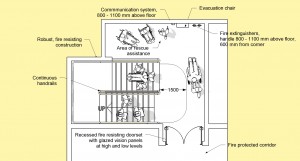2009-03-10: Regarding Seán’s Comment, dated 2009-03-06.
Yes, the guidance provided in Technical Guidance Document B (Ireland) is inadequate … and the same can equally be said of Approved Document B (England & Wales).
And yes, you will find only partial answers in British Standard BS 9999, even though it was only published on 31st October 2008 last.
Access Consultants in Ireland and Great Britain rarely deal with any matters relating to fire safety in buildings.
Please allow me, therefore, to fill in some gaps for you. The following guidance is suitable for application in any European country …
People with Activity Limitations (2001 WHO ICF) experience many difficulties when attempting to independently evacuate a fire building. However, our reasoning is very simple. If we can get things right for the most vulnerable building users, we get them right for everyone else also.
The Target Destination … whether evacuation is independent, assisted by other building users or accomplished by means of firefighter rescue … is a ‘Place of Safety’. This term is not well defined in legislation or codes.
Building User ‘Place of Safety’:
Any location beyond a perimeter which is [100] metres from the fire building or a distance of [10] times the height of such building, whichever is the greater … and … where necessary and effective medical care and attention can be provided, or organized, within one hour of injury … and … where people can be identified.
Where there is a Risk of Explosion … multiply the numbers in square brackets above by 4 (at least !).
All Fire Evacuation Routes – inside and outside a building – should comply with Accessibility Design Criteria. This is an entirely alien concept to many Fire Prevention Officers in Local Authorities, and Fire Consultants !
Panic Attacks, during evacuation in a ‘real’ fire incident, exist.
Standard Movement Times, during evacuation in a ‘real’ fire incident, do not exist.
People should be able to reach an ‘Area of Rescue Assistance’ inside a building with ease. In practice, few people understand what the word ‘refuge’ means (as in … refuge point, refuge area, area of refuge, etc). As a result, these spaces are regularly misused and/or abused in buildings. And there is great difficulty translating a word into other languages which, in English, can have so many meanings. In Italian fire safety legislation, for example, ‘refuge’ has been translated as ‘spazio calmo’. How crazy is that ?
So … what is an ‘Area of Rescue Assistance’ ?
A building space directly adjoining, and visible from, a main vertical evacuation route – robustly and reliably protected from heat, smoke and flame during and after a fire – where people may temporarily wait with confidence for further information, instructions, and/or rescue assistance, without obstructing or interfering with the evacuation travel of other building users.
This is a notional Area of Rescue Assistance …
A Clear Evacuation Width of 1.5 metres on the Evacuation Staircase facilitates ‘contraflow’ in a fire emergency (shown on the lower flight of stairs), i.e. emergency access by firefighters entering a building and moving towards a fire, while building users are moving away from the fire and evacuating the building … as well as allowing sufficient space to safely carry an occupied wheelchair down the staircase (shown on the upper flight of stairs).

Evacuation Skills & Self-Protection from Fire in Buildings …
A ‘skill’ is the ability of a person – resulting from adequate training and regular practice – to carry out complex, well-organized patterns of behaviour efficiently and adaptively, in order to achieve some end or goal.
Building users should be skilled for evacuation to a ‘place of safety’, and test/drill/non-emergency evacuations should be carried out sufficiently often to equip building users with that skill. Consideration should be given to practicing evacuation once every month or, at most, every two months; once a year is inadequate. In the case of people with a mental or cognitive impairment, there is a particular need to encourage, foster and regularly practice the adaptive thinking which will be necessary during a ‘real’ fire incident.
Since Fire Protection Measures and Human Management Systems are never 100% reliable … it is necessary for frail older people and building users with disabilities to be familiar with necessary guidelines for self-protection in the event of a fire emergency.
Assisted Evacuation & Rescue Techniques …
Firefighters have two functions:
– fighting fires ; and
– rescuing people who are trapped in buildings, or for some reason, cannot independently evacuate a building which is on fire.
People with disabilities are participating more and more, and in ever increasing numbers, in mainstream society. It is necessary, particularly for firefighters, to become skilled in how best to rescue a person with a disability from a building, using procedures and equipment which will not cause further harm or injury to that person.
Manual handling of occupied wheelchairs in a fire evacuation staircase, even with adequate training for everyone directly and indirectly involved, is hazardous for the person in the wheelchair and those people – minimum three – giving assistance.
Generally … Powered Wheelchairs are too heavy for manual handling in any situation.
For these reasons, all lifts/elevators in new buildings should be capable of being used for fire evacuation. Lifts/elevators in existing buildings, when being replaced or undergoing major overhaul, should then be made capable of being used for fire evacuation.
Local Fire Authorities should ensure that they possess the necessary equipment to rescue people with a wide range of impairments, and that specialized rescue equipment is regularly serviced and maintained. Every Fire Authority should have an ‘accessible’ and ‘reliable’ Emergency Call System which is available, at all times, to the public within its functional area.
It is essential that every Firefighter is fully aware of this important public safety issue, and is regularly trained in the necessary rescue procedures involving people with a wide range of impairments.
.
.
END

